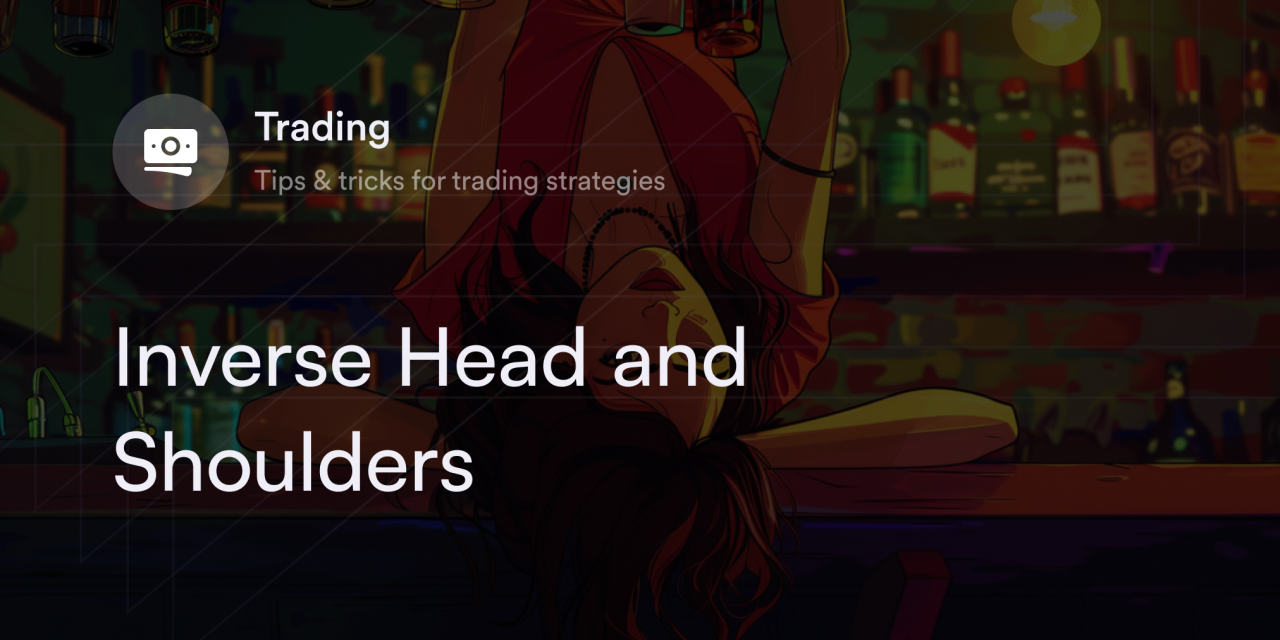


There’s no denying bear markets are gloomy. During these phases, market sentiment often hits a low, but there's a pattern that traders keenly watch due to its power to reverse the tide. Enter the inverse head and shoulders pattern, a notable formation in technical analysis that heralds a potential shift from bearish to bullish momentum, offering traders a glimmer of hope.
In this guide, we’ll review the intricacies of this pattern, breaking down its essential components. We'll also explore how its emergence signals a turning point in market sentiment and provide practical tips and examples for trading this pattern effectively.
What is the inverse head and shoulders?
The inverse head and shoulders is a technical analysis pattern that predicts when a strong downtrend moves toward a bullish reversal and trades that reversal accordingly. It resembles an upside-down head and shoulders and has a deep “head” trough flanked on either side by two shallow “shoulders.”
The pattern appears during a downtrend after three successive dips and rallies—one larger trough sandwiched between two smaller and similarly sized troughs—after which a bullish reversal occurs and prices rise. Together with a “neckline” drawn through each high point, these dips trace three distinct valleys resembling a head and shoulders. A slanted head and shoulders pattern has a sloping neckline.
Once the breakout occurs and the trend reversal is suspected, traders usually open a long position to take advantage of the rising price.
Elements of the inverse head and shoulders pattern
Whether trading crypto, inverse head and shoulders patterns can be a great way to predict when a declining asset may be shifting gears. Like any technical analysis pattern, the pattern includes a few core elements and must meet essential conditions.
Lead-in downtrend
As a bullish reversal pattern, every reversal head and shoulders pattern begins with a strong downtrend.
Left shoulder
The inverse chart begins to take shape when the price reaches a low before retracing to a higher point. This trough shape forms the left shoulder.
Head
Next, the price declines to a point lower than the left shoulder before rallying back up to a high close to the top of the left shoulder. The head’s shape is more extensive but closely resembles the left shoulder.
Right shoulder
The formation of the right shoulder mirrors the left shoulder: a similar price drop followed by a similar rally. This completes the formation.
Neckline
The neckline is a trendline drawn between the high points, reached after each pattern element is formed. A bullish reversal may begin once the price breaks through this resistance line.
Reversal breakout
The event that activates the pattern is the breakout of prices through the neckline, shattering resistance and triggering a trend reversal into a bull market.
What is the psychology around the inverse head and shoulders chart pattern?
The psychology behind the inverse head and shoulders chart pattern is rooted in market sentiment and trader behavior. This pattern reflects a turnaround in market psychology from bearish to bullish, indicating a potential shift in the trend.
As a bullish reversal pattern, the initial sentiment around the asset is negative as prices fall. The left shoulder takes shape when a short rally is triggered by traders thinking the asset may be undervalued.
Prices begin to fall again as the controlling bearish sentiment retakes control, forming the left half of the head. After dropping even lower than the left shoulder, panic selling may depress prices further until new entrants with a favorable view of the asset see an opportunity to buy low and set off another rally up to the neckline.
With bearish sentiment still robust but waning, prices decline again, but not as low as the head, showing that overall sentiment begins to lean toward the bulls. Finally, bullish sentiment takes control, the price can break through the neckline, and the bull run may be upcoming.
How to trade an inverse head and shoulders pattern
Trading the inverse head and shoulders pattern requires a strategic approach to capitalize on its potential. This pattern can strongly indicate an impending upward price movement if traded correctly. Here are six steps to follow:
1. Identify the pattern
The first step in trading an inverse head and shoulders pattern is finding one on a price chart. Look for three troughs: the left shoulder, the head, and the right shoulder, with the head being the lowest point. Ensure the pattern forms at the end of a downtrend.
2. Determine the neckline
Draw the neckline by connecting the high points of the formation (the peaks after the left shoulder and the head). This neckline acts as a resistance level and is key to confirming the pattern.
3. Enter a trade
A common entry point is when the price breaks above the neckline, indicating a potential bullish reversal. Wait for a candle to close above the neckline for confirmation before entering the trade to avoid false breakouts.
4. Manage risks
Implement risk management strategies, like placing a stop-loss order below the right shoulder or below the lowest point of the head, depending on your risk tolerance. This limits potential losses if the market doesn't move as expected.
5. Set profit target
Set a realistic profit target to ensure a favorable risk-reward ratio. A common approach is to measure the vertical distance from the head's lowest point to the neckline and project that distance upward from the breakout point.
6. Exit the trade
Monitor the trade and be prepared to exit if the price reaches the profit target or if market conditions change unfavorably. Also, consider exiting if the price falls below the neckline after the breakout.
Tips for trading inverse head and shoulder patterns
While trading the inverse head and shoulders pattern isn’t complicated, there are some caveats and best practices to consider for the highest chance of success. Here are a few:
Use volume for confirmation
A breakout above the neckline is a good sign and a necessary component of a successful head and shoulders pattern, but high volume into the breakout can add further certainty to the confirmation.
Conversely, low volume can mean traders deal with a failed inverse head and shoulders pattern, and the downtrend will resume.
Wait for a retest
Waiting for a neckline retest (which now represents support) after a breakout can further ensure that bullish sentiment remains dominant and the uptrend will continue. A retest is also a secondary entry point for traders who couldn’t catch the initial breakout.
Don’t jump the gun
While it may be tempting to open an early position when an emerging inverse head and shoulders pattern looks inevitable, waiting for the breakout and solid volume indicators to confirm the reversal is vital to avoid entering during the downtrend.
Use technical analysis indicators
Technical analysis indicators help confirm that a strong trend reversal has taken place.
For example, a relative strength index (RSI) value above 70, a stochastic value above 80, and a rising volume oscillator further assure that the bulls have taken control.
Example of an inverse head and shoulders chart pattern
The inverse head and shoulders pattern is a powerful tool in theory, but how does it work in the real world? Here’s a practical example to help traders better understand how to identify the pattern, interpret its implications, and apply this knowledge in their trading decisions.
An inverse head and shoulders pattern occurred in the Bitcoin (BTC) market over 2019–2020.
BTC witnessed a long downtrend in 2019, but optimistic buyers planned to rally a retracement from $6,500 to $10,500 in December, creating the left shoulder of the pattern. Due to short-term traders selling their crypto to earn profits, bearish sentiment resumed its dominant role and pushed prices down to $3,750 in March 2020.
Optimistic bulls then took advantage of the dip, bringing prices back to the neckline at about $10,500 and forming the head. With reduced selling pressure, a shallower decline in price to about $9,000 formed the first half of the right shoulder until the bulls began buying in earnest, breaking resistance and pushing the price right through the neckline.
With the lowest point of the head at $3,750 and the neckline at $10,500, there was a difference of $6,750 above the neckline at $10,500 to arrive at a price target of about $17,250.
Up your crypto knowledge with dYdX Academy
Get control of your trades by learning the tips and tricks of the crypto world. Check out dYdX Academy, our in-house resource library that includes easy-to-understand guides on all things blockchain.
dYdX also offers eligible traders low-fee crypto perpetuals trading for Bitcoin and dozens of altcoins on our decentralized exchange. Find out more about dYdX's latest news and features on our official blog, and eligible traders can start trading on dYdX today.
Disclosures
The content of this article (the “Article”) is provided for general informational purposes only. Reference to any specific strategy, technique, product, service, or entity does not constitute an endorsement or recommendation by dYdX Trading Inc., or any affiliate, agent, or representative thereof (“dYdX”). Use of strategies, techniques, products or services referenced in this Article may involve material risks, including the risk of financial losses arising from the volatility, operational loss, or nonconsensual liquidation of digital assets. The content of this Article does not constitute, and should not be considered, construed, or relied upon as, financial advice, legal advice, tax advice, investment advice, or advice of any other nature; and the content of this Article is not an offer, solicitation or call to action to make any investment, or purchase any crypto asset, of any kind. dYdX makes no representation, assurance or guarantee as to the accuracy, completeness, timeliness, suitability, or validity of any information in this Article or any third-party website that may be linked to it. You are solely responsible for conducting independent research, performing due diligence, and/or seeking advice from a professional advisor prior to taking any financial, tax, legal, or investment action.
You may only use the dYdX Services in compliance with the dYdX Terms of Use available here, including the geographic restrictions therein.
Any applicable sponsorship in connection with this Article will be disclosed, and any reference to a sponsor in this Article is for disclosure purposes, or informational in nature, and in any event is not a call to action to make an investment, acquire a service or product, or purchase crypto assets. This Article does not offer the purchase or sale of any financial instruments or related services.
By accessing this Article and taking any action in connection with the information contained in this Article, you agree that dYdX is not responsible, directly or indirectly, for any errors, omissions, or delays related to this Article, or any damage, injury, or loss incurred in connection with use of or reliance on the content of this Article, including any specific strategy, technique, product, service, or entity that may be referenced in the Article.







